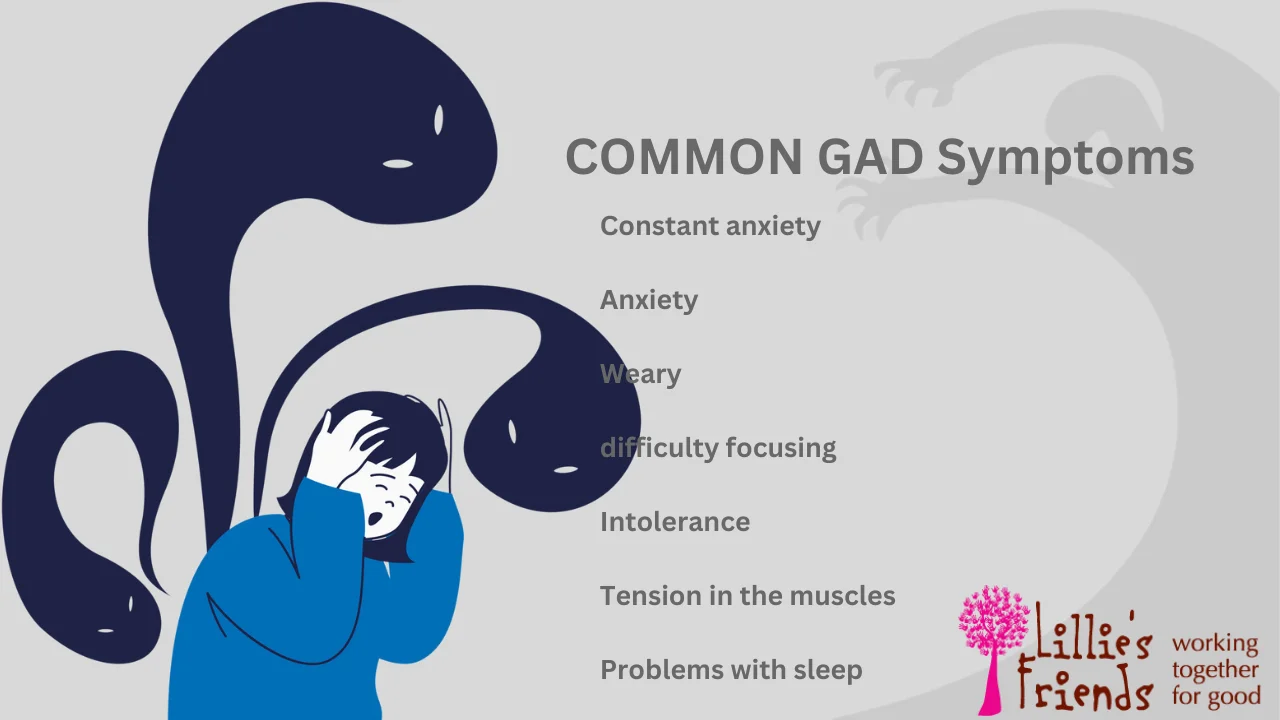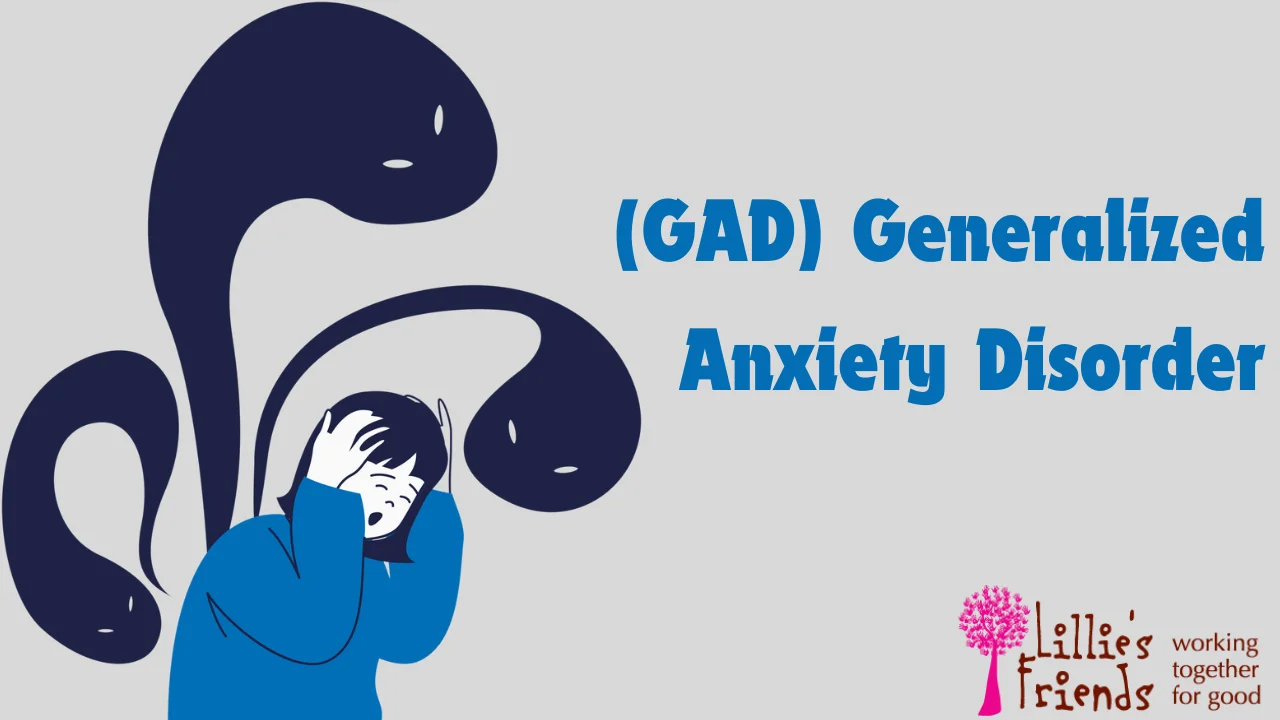A common mental health illness called generalized anxiety disorder (GAD) is characterized by excessive, unrelenting worry about a variety of everyday situations. Unlike specialized phobias or panic disorders, which usually have identifiable triggers, generalized anxiety disorder (GAD) is not limited to a single worry or experience. Rather, it permeates a person’s daily existence, potentially upsetting their personal, academic, and professional lives.
The National Institute of Mental Health (NIMH) estimates that 5.7% of adult Americans [1*] have had generalized anxiety disorder at some point in their life. Women are diagnosed with it more often than males since they are twice as vulnerable. It is acknowledged as a chronic illness that might last for many years or perhaps a lifetime, particularly in the absence of suitable therapy.

Signs and symptoms of Generalized Anxiety Disorder
Adults with generalized anxiety disorders may exhibit a range of psychological, emotional, and physical symptoms. The primary indicator is persistent and severe anxiety over many aspects of life, including work, health, family, finances, and education. The anxiety is usually greater than the actual likelihood or effects of the circumstance causing the fear.
In addition to mental symptoms, people with GAD may also have a range of physical ones, such as
- Anxiety or heightened mood
- Weary
- inability to concentrate
- Intolerance
- Tension in the muscles
- disruptions to sleep
These symptoms must cause significant discomfort or interfere with everyday activities for a minimum of six months to be officially diagnosed as GAD.
Differentiating Between GAD and Other Mental Health Conditions
Given that the symptoms of generalized anxiety disorder might coincide with those of other mental health illnesses, diagnosing it can be challenging. This is a detailed comparison between generalized anxiety disorder (GAD), panic disorder, post-traumatic stress disorder, and other conditions.
Anxiety vs. GAD
Tension and concern are frequent characteristics of anxiety, which often arises in reaction to stimuli. Conversely, generalized anxiety disorder is a mental health illness characterized by persistent, excessive concern that interferes with day-to-day functioning. In contrast to typical stress-related anxiety, generalized anxiety disorder (GAD) does not go away and often centers on issues related to family, money, or health.
Anxiety vs Panic Disorder
Although major anxiety is a feature of both GAD and panic disorders, they are not the same. Anxiety that is episodic and manifests as abrupt panic episodes that are physically and emotionally distressing is known as a panic disorder. In contrast, GAD is characterized by chronic, persistent anxiety that is accompanied by excessive concern over a wide range of life conditions.
PTSD vs. Generalized Anxiety Disorder (GAD)
Usually brought on by a terrible experience, post-traumatic stress disorder (PTSD) manifests as intense anxiety, nightmares, and flashbacks. In GAD, anxiety is often more sporadic and unrelated to a single incident that occurs in various daily contexts.
OCD with Generalized Anxiety Disorder (GAD)
The hallmarks of OCD are a pattern of unrelenting, recurrent thoughts known as obsessions and compulsive, repetitive behaviors that follow the obsessions. While high levels of concern are shared by both OCD and GAD, OCD is characterized by intrusive thoughts and habitual actions, while generalized anxiety disorders are characterized by pervasive distress.
GAD Causes and Risk Factors
There is still much to learn about the specific causes of GAD. It is believed that several interrelated elements contribute to its development. Among them are
- Natural elements. Neurotransmitter alterations in the brain, especially those involving serotonin and noradrenaline, may have an effect.
- Factors that are genetic. An person is more likely to acquire GAD if a close family member—such as a parent or sibling—has it.
- Life experiences play a significant role. A history of major life transitions, traumatic experiences, chronic stress, and other psychological factors may exacerbate GAD. Abuse, neglect, or early parent loss in childhood also raise the risk.
- Character traits. A person may be more susceptible to GAD if they have certain personality characteristics, including perfectionism, poor self-esteem, or an intense desire for control.
The following are some risk factors for generalized anxiety disorders:
- The gender. Compared to men, women are diagnosed with GAD more often.
- Age. Although generalized anxiety disorder in adults may strike at any moment, it often begins in childhood or middle age and progresses gradually.
- long-term health issues. GAD is more common among those who have long-term medical issues like diabetes or heart disease. On the other hand, GAD may make these health issues worse.
- Abuse of substances. Alcohol use, drug usage, and caffeine may all exacerbate GAD.

How Can GAD Be Identified?
To diagnose a generalized anxiety disorder, the following procedures are usually followed:
- Medical assessment. A thorough medical examination aids in the evaluation of GAD symptoms and the exclusion of anxiety-causing physical or drug-related conditions. Medical testing and a review of medical history may also be part of this phase.
- Psychological assessment. It calls for completing the questionnaire and speaking with a mental health professional about symptoms, emotions, thoughts, and behaviors.
- criterion for diagnosis. A medical professional may diagnose GAD if the patient’s symptoms and other physical characteristics match the criteria listed in the Diagnostic and Statistical Manual of Mental Disorders (DSM-5).
Treatment Options for Generalized Anxiety Disorder?
Treatment for Generalized Anxiety Disorder (GAD) is often all-encompassing, frequently combining medication, psychiatric counseling, and customized lifestyle modifications.
Behavioural Cognitive Therapy
Generalized anxiety disorder responds extremely well to cognitive behavioral treatment (CBT). It teaches individuals how to think and act differently in anxious circumstances. CBT may also assist in understanding and treating the bodily manifestations of anxiety.
Drugs
GAD may be treated with the sorts of drugs [2*] listed below:
- Antidepressants, especially those classified as serotonin and norepinephrine reuptake inhibitors (SNRIs) and selective serotonin reuptake inhibitors (SSRIs). We could also suggest several additional antidepressants, such as venlafaxine or duloxetine, as anti-anxiety drugs.
- Benzodiazepines, which may be used to temporarily relieve acute anxiety symptoms but may become addictive if taken over an extended period of time.
- Buspirone, an anxiety-reducing drug.
Modifications to Lifestyle to Help Reduce GAD Symptoms
Anxiety may be controlled by regular exercise, a balanced diet, abstaining from alcohol and caffeine, keeping a regular sleep pattern, and engaging in mindfulness and yoga.
GAD complications
If left untreated, generalized anxiety disorder may have a major negative influence on a person’s quality of life. The chronic nature of this illness and its effects on both physical and mental health may cause several issues, including:
- The emergence of drug use disorders and depression is a pressing concern.
- There are particular physical health concerns, such as chronic pain, digestive difficulties, respiratory illnesses, and cardiac ailments.
- There is difficulty in carrying out daily duties, holding down a job, or maintaining relationships, which results in social isolation.
- The patient has an extreme generalized anxiety disorder that leads to suicidal thoughts or actions.
Options for Prevention
While it may not always be possible to avoid generalized anxiety disorders, there are steps you can take to lower your risk and improve symptom management.
- Timely diagnosis
- Consistent exercise
- A nutritious diet
- Good sleeping habits
- Stress-reduction strategies
- Solid social ties
- Drinking in moderation and abstaining from illegal substances
- Frequent examinations
In summary
Stigmatized individuals often face rejection and discouragement from seeking treatment. However, it’s crucial to understand that anxiety is curable. Speaking with a healthcare professional enables more than just getting an accurate diagnosis, figuring out what causes the condition, and selecting the best course of action.
FAQ
What does it feel like to live with anxiety?
Anxiety may have the effect of a continuous, erratic mental alert that is upsetting and uncomfortable on both a physical and emotional level. Individuals suffering from generalized anxiety disorder may have intrusive concerns, exhaustion, agitation, and difficulty falling asleep. They might struggle to unwind, often overanalyze and magnify small things, and struggle in social situations. Recall that there are treatments for anxiety disorders, and if your symptoms are severe enough to interfere with your everyday life, you should get help from a specialist.
Can people with GAD have a normal life?
Indeed, GAD sufferers may have happy, fulfilled lives. Sufficient management of symptoms and mitigation of the illness may be achieved with appropriate treatment, including medication, psychotherapy, and self-help coping skills.
What is an example of a generalized anxiety disorder?
Abnormal and persistent concern about a range of commonplace scenarios is one of the early warning indicators of generalized anxiety disorders. For instance, a person may worry unnecessarily about their family’s safety, their health, or the stability of their work. Uncontrollably worrying may cause bodily symptoms including weariness, restlessness, and insomnia.
Who is most likely to have generalized anxiety disorder?
Anyone may have GAD, although some people are more vulnerable than others. GAD is diagnosed in women more often [2*] than in men. Although the condition may start at any age, it usually manifests itself between childhood and maturity. Having a close family member with GAD might raise one’s risk due to genetic reasons. Individuals who have gone through hardship or trauma, especially as children, are more vulnerable.
What is the difference between GAD and severe anxiety?
While GAD is a chronic disorder characterized by excessive worry that interferes with everyday living, anxiety is a natural reaction to stress. Regardless of particular causes, GAD remains and often affects family, economics, or health. Diagnosis occurs when such intense concern continues for six months or more.











